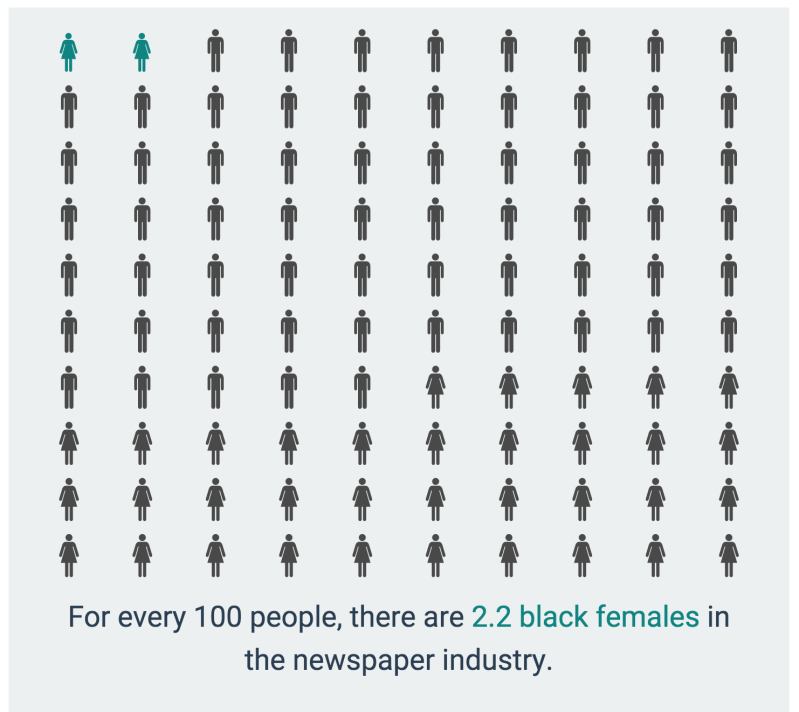The word diversity makes some optimistic, others scurry, and a number of people not even flinch. However, the cat is out of the bag for newsrooms. For every 100 people in the newsrooms 87.3 percent are white according to a news interactive on Poynter based on a newsroom census released by the American Society of News Editors (ASNE).
If newsrooms are supposed to be reflective of the world we live in, statistics show they are missing the mark.
This weekend at the Online News Association Conference in Los Angeles, the non-profit organization aims to highlight the issue by hosting a number of panels and workshops discussing what can be done to improve diversity in newsrooms.
“The first thing is having awareness of your unconscious bias. If upper management, let’s say hypothetically is upper age white males, they’re probably going to hire someone who looks like them. When you meet someone, you’re looking for connections, they’re looking at ‘oh we went to the same school,’ ‘do we shop at the same market?” Hugo Balta, a hiring manager a and senior director of multicultural content digital & print media at ESPN said after attending a workshop about diversifying the newsroom at ONA.
“If ESPN is going to remain relevant and competitive in the marketplace, then it needs to be reflective of the increasing numbers of our multicultural audience. The best way to do that is ensure the decision makers and content creators are a part of those communities.”
This. Is. Depressing. For every 100 people, there are 2.2 black females in the newspaper industry. http://t.co/M4wnWsY2nD via @poynter
— Denise Clay (@denisethewriter) July 29, 2015
The dynamics of awareness
According to the ASNE, as of July 28 , about 12 percent of journalists in newsrooms are minorities. The report also report claims that 63 percent of newsrooms’ top three editors are women.
ONA prides itself with the diversity of conference speakers this year with 52 percent women, 36 percent people of color, 25 percent local news and eight percent international representation. This example of shows improving diversity is beyond having more people of color in newsrooms. Diversity includes ethnicity, age, disabilities, religion, socio economic background, and much more.
“Not all smart people look like me. I don’t have all the wisdom. One of the things I look for when I hire someone is somebody who can teach me something that I don’t know.” Emmanuel Touhey a hiring manager at CNN’s C-Span said.
“I don’t want people who agree with me because that’s boring. I want people who are going to challenge me.”
Diversity in personnel and coverage
When the L.A. Times made a move to become more culturally inclusive of minorities about two months ago, the internet went crazy. Headlines blazed/burst/exploded across social media reading, “L.A. times hires #BlackTwitter writer.” Though he writes about more than just #BlackTwitter, Dexter Thomas Jr., who is also in the process of obtaining his Ph.D in Japanese hip hop, insists that the hire was necessary.
“I think that goes to show that people have been able to but their information and concerns on the forefront.” Thomas Jr. said in regards to people being able to voice their concerns about diversity in the workplace on Twitter.
“We absolutely need more conversations about culture and racial issues.”
Letoya Peterson, a deputy editor at Fusion did just that when she was looking for a diverse pool of candidates for jobs at NPR a few years ago. She tweeted about the application and even sent out the notification to different list servers which she claims resulted in a diverse pool of applicants for NPR’s summer internships for young journalists. Now she travels to different companies and conferences instructing hiring managers on how to increase diversity in their applicant pool and the type of methods they should use in order to do so.
“All of us have to become the best. Everybody was tweeting that Scandal line because it was true. You have to be twice as good to go half as far because whenever you consider race people immediately go for affirmative action and say oh you’re not qualified.” Peterson said.
Getting that diverse pool of applicants is the sole mission for Amanda Willis of Mashable HQ. After her company’s HR department had a conference call about six months ago admitting that diversity is a problem, she has been promoting jobs and internships at her company to various and sometimes lesser known school and institutions.
“We’ve gotten a little bit more of a diverse applicant pool but not to the point that I want.” Willis said.
“I’ll just be honest and say it. It generally hurts your coverage if everyone is white. Even if the story has nothing to do with race.”
Willis is making a positive effort, but she and the rest of hiring managers in the media industry a long ways to go. The question is, have all hiring managers with a diversity issue recognized their problem and are working to correct it?





